Greenland Sled Dog – 9,500 years
Although not recognized as a breed by the AKC, the Greenland sled dog has a similar appearance to the Husky and Alaskan Malamute. Genetically speaking, however, it’s very different, having adapted to “eating a very high-fat diet, running and pulling sleds in a low-oxygen environment, and the ability to highly regulate their body temperatures.”
In this sense, they are more closely related to the dog discovered in Zhokhov and, unlike other dog breeds, show no signs of interbreeding with the gray wolf in the past 9,500 years.
According to researchers, the fact that Greenland sled dogs lack the genetic adaptations other breeds have made to cope with diets heavy in sugar and starch “emphasizes that sled dogs and Arctic people have worked and adapted together for more than 9,500 years.”
Since 2018, however, the Greenland sled dog has seen a dramatic population decline that could lead to extinction. Climate change has made traditional hunting methods ineffectual and caused a decline in available food sources. At the same time, epidemics of parvovirus and distemper have destroyed many subpopulations.
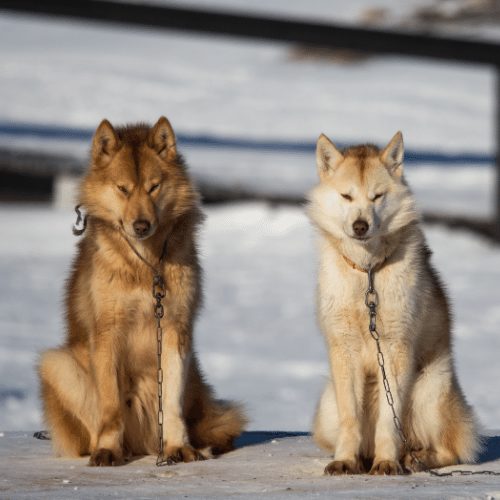
A strong, willful, and muscular dog, the Greenland sled dog has spent thousands of years working with humans – let’s hope something can be done to ensure it carries on for many more to come.

While many believe that the Afghan Hound originated in the deserts of Egypt, its name suggests otherwise, and a more realistic theory is that they were bred by the nomadic people of Afghanistan and its neighboring regions.
As fast and powerful as any other breed of sighthound, the Afghan was originally used to hunt game, including antelopes and, according to some, leopards. Eyewitnesses say the Afghan would grab its dangerous prey by the neck, “severing the leopards’ spines in their jaws.”
Afghan hounds caught the eye of British soldiers who took them back to the UK with them, exhibiting them at dog shows under various names, including Persian Greyhounds and Barukzy hounds.
Closely related to the Saluki, Afghans have an independent streak that harks back to their hunting origins and can be stubborn and aloof. These traits make them difficult to train, especially as they have an exceptionally high prey drive.
With its long, flowing locks and striking appearance, the Afghan Hound is a champion in the showing and makes for a loyal and entertaining companion that can be both quiet and dignified and downright clownish as the mood takes him.
Closely related to the sighthounds depicted in the temple drawings from 6,000 BC discovered in present-day Turkey, the Greyhound is one of the oldest dog breeds in the world.
While some are convinced the dog depicted on graves, inscriptions, and tomb paintings was, in fact, a Greyhound, others believe it has more in common with the Basenji or Saluki.
There’s no doubt that the Greyhound descended from these ancient Egyptian predecessors, taking on the role of hunter, as well as companion and guard dog.
By the Middle Ages, the Greyhound was nearly extinct, as widespread famine swept across Europe. The breed was saved by clergymen who went on to breed them for nobility, giving the Greyhound its revered status as a companion to the aristocracy.
Intelligent, independent, and fleet-footed, the Greyhound is a gentle, affectionate dog that is eager to please.

A high prey drive means they’re not the easiest dogs to have around if you’ve got rabbits or guinea pigs, but if you want a quiet, mild-mannered companion, a Greyhound is ideal.
Greyhounds also make great running partners – as long as you don’t try to keep up with them – and, with their speed and dexterity excel at both agility and obedience.
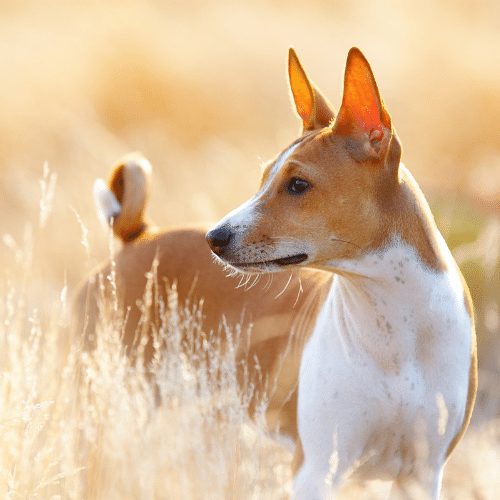
Like the Greyhound, the Basenji is believed to be related to the dogs of Ancient Egypt, although others claim it originated in Africa.
Having been isolated in remote regions, the Basenji has maintained many of the unusual traits of its ancient predecessors and displays more catlike behavior than most dog breeds.
Not only does the Basenji lack that distinctive doggy smell, but it also yodels rather than barks and is as fastidious about its appearance and cleanliness as a cat.
It’s believed that the Basenjis were once prized “as versatile hunters with keen eyesight, explosive speed, and a highly developed sense of smell.”
To cope with the tall grasses of the African savanna, the breed also developed a unique ability to leap vertically in the air. One of its African names translates as “the jumping-up-and-down dog.”
Something of a “cult breed,” the Basenji made it into 86th place in the AKC’s list of the most popular breeds of 2020. Clean, odor-free, intelligent, and inquisitive Basenjis are excellent guard dogs and loyal companions.
Constantly alert, the Basenji needs plenty of exercise and mental stimulation but will reward your efforts with their entertaining and amusing personalities.
Mastiffs of all types (such as the Korean Mastiff) have been around for thousands of years but the Tibetan is believed to be the oldest.
A phylogenetic analysis performed in 2008 lead researchers to conclude “that the approximate divergence time between Tibetan Mastiff and the gray wolf was 58,000 years before the present (YBP), and the approximate divergence time between other domestic dogs and the gray wolf was 42,000 YBP.”
The Mastiff is one of the oldest dogs, and it’s believed to have descended from the war dogs of ancient Rome, although there is little genetic evidence to support this theory. Nevertheless, they do share a certain likeness with the legendary Molossus which Aristotle described as being both larger than other dogs “and more fierce in their attack on wild beasts.”
Tibetan Mastiffs were originally used as guard dogs, protecting both property and livestock, so it’s hardly surprising that they are very territorial dogs. While gentle and affectionate with family members, Tibetan Mastiffs can be aggressive towards strangers and, as a result, have been banned in parts of the US, France, and Australia, among other places.
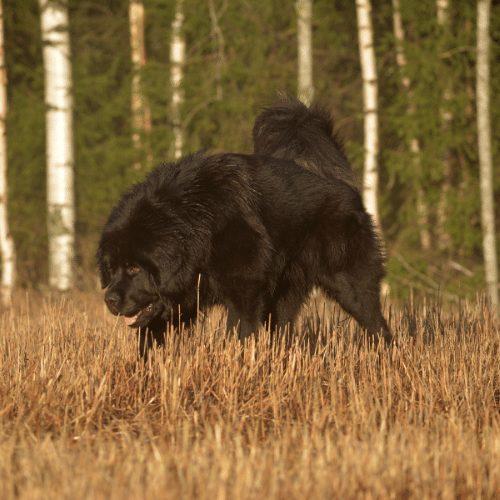
Despite such bans, the Tibetan Mastiff remains a popular breed, celebrated for its intelligence, independence, strength, and loyalty. Because of their tendency to display potentially reactive behavior, keep your Mastiff on a collar and leash at all times.
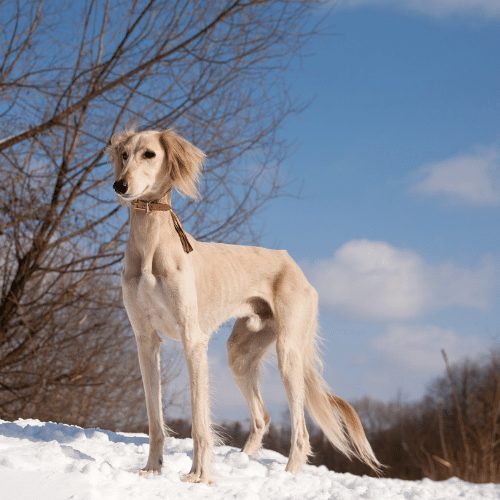
The Saluki currently holds the Guinness World Record for being the oldest breed of dog in the world.
Although new research may have undermined that claim, its ancient origins are undeniable. Archaeologists uncovered a golden pendant depicting a Saluki that dated back to 3,300BCE while the remains of mummified Salukis have been discovered in ancient tombs in the Upper Nile region.
These elegant dogs were highly valued by Arab tribesmen and Egyptian nobility alike. As high-speed sighthounds, they were prized for their speed, endurance, and keen hunting instinct.
Capable of reaching speeds of up to 42 mph, the Saluki was most famously used to hunt gazelle but, in the mountainous terrain of northern Iran and Turkey, it adapted to the environment, becoming “bigger, heavier, [and] hairier” to cope with larger prey, like deer.
Curious, loyal, and yet independent, the Saluki is an athletic dog that excels in competition, showing an aptitude for activities such as agility, lure coursing, and jumping. Despite their hunting origins and high prey drive, Salukis make dignified and gentle family pets as long as they get plenty of exercise and mental stimulation.
Thousands of years ago, the forebears of the Alaskan Malamute crossed from Siberia into Alaska, where it developed into a breed similar to the one we know today. Used to pull sleds, hunt seals, and defend against polar bears, the Alaskan Malamute was highly valued.
Its name is derived from the name of the Inuit people, the Mahlemiut, who inhabited the northwestern region of Alaska known as Kotzebue Sound.
Being an isolated tribe meant that the Alaskan Malamute survived the Gold Rush of 1896 relatively intact, although cross-breeding almost caused the breed’s extinction.
Fortunately, the Alaskan Malamute proved more capable of surviving the cold weather and harsh winters of Alaska – a characteristic that ensured its continued survival.
A powerful and athletic breed, the Malamute is known for its endurance and ability as a working dog, but they also make great pets. Playful and occasionally mischievous, the Alaskan Malamute is a wonderful family companion for experienced dog owners.
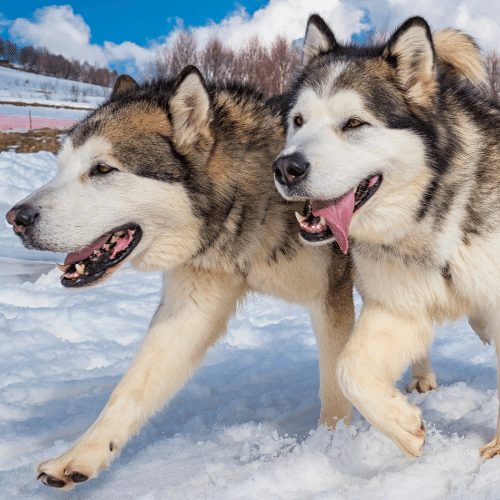
They often participate in agility and obedience trials and need plenty of vigorous exercise. Their friendly temperaments make them poor watchdogs but loving companions, although they can become destructive if not given adequate exercise.
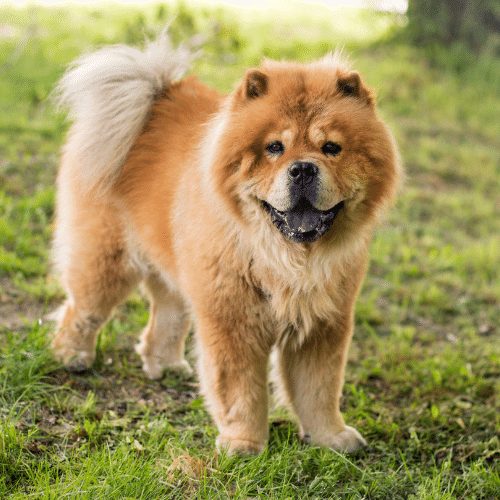
) Afghan Hound (3,000 or more years ago)

There is some debate about the origins of this beautiful dog. Some believe they come from Egypt, while others believe in Afghanistan, as the name suggests. Long silky hair, narrow face, and thin build give this breed an unmistakable elegance.
This hound is known for speed and was used for hunting antelopes and leopards. Before long, British soldiers took them and brought them back to the UK as show dogs. Some feel they are not smart dogs, but in fact, they can be stubborn when you try to train them, preferring to keep their hunting instincts intact.
Afghan hounds will do well in any family, but be prepared to do many brushing and exercising to keep up with their energy level. They do well in warm and cold climates and adapt very well to their living circumstances. A sociable dog, they like plenty of attention from their owners.